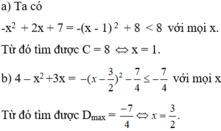

Hãy nhập câu hỏi của bạn vào đây, nếu là tài khoản VIP, bạn sẽ được ưu tiên trả lời.



\(A=\left(x-1\right)^2+8\ge8\\ A_{min}=8\Leftrightarrow x=1\\ B=\left(x+3\right)^2-12\ge-12\\ B_{min}=-12\Leftrightarrow x=-3\\ C=x^2-4x+3+9=\left(x-2\right)^2+8\ge8\\ C_{min}=8\Leftrightarrow x=2\\ E=-\left(x+2\right)^2+11\le11\\ E_{max}=11\Leftrightarrow x=-2\\ F=9-4x^2\le9\\ F_{max}=9\Leftrightarrow x=0\)

Lời giải:
a.
$C=16-3(x^2+4x+4)=16-3(x+2)^2$
Vì $(x+3)^2\geq 0$ với mọi $x\in\mathbb{R}$
$\Rightarrow C\leq 16-3.0=16$
Vậy $C_{\max}=16$ khi $x=-2$
b.
$D=-x^2+5x=2,5^2-(x^2-5x+2,5^2)$
$=6,25-(x+2,5)^2\leq 6,25-0=6,25$
Vậy $D_{\max}=6,25$ khi $x=-2,5$
c.
$M=2x-x^2=1-(x^2-2x+1)=1-(x-1)^2\leq 1-0=1$
Vậy $M_{\max}=1$ khi $x=1$
a: Ta có: \(C=-3x^2-12x+4\)
\(=-3\left(x^2+4x-\dfrac{4}{3}\right)\)
\(=-3\left(x^2+4x+4-\dfrac{16}{3}\right)\)
\(=-3\left(x+2\right)^2+16\le16\forall x\)
Dấu '=' xảy ra khi x=-2
b: Ta có: \(D=-x^2+5x\)
\(=-\left(x^2-5x+\dfrac{25}{4}\right)+\dfrac{25}{4}\)
\(=-\left(x-\dfrac{5}{2}\right)^2+\dfrac{25}{4}\le\dfrac{25}{4}\forall x\)
Dấu '=' xảy ra khi \(x=\dfrac{5}{2}\)

Answer:
a) \(\frac{5x}{2x+2}+1=\frac{6}{x+1}\)
\(\Rightarrow\frac{5x}{2\left(x+1\right)}+\frac{2\left(x+1\right)}{2\left(x+1\right)}=\frac{12}{2\left(x+1\right)}\)
\(\Rightarrow5x+2x+2-12=0\)
\(\Rightarrow7x-10=0\)
\(\Rightarrow x=\frac{10}{7}\)
b) \(\frac{x^2-6}{x}=x+\frac{3}{2}\left(ĐK:x\ne0\right)\)
\(\Rightarrow x^2-6=x^2+\frac{3}{2}x\)
\(\Rightarrow\frac{3}{2}x=-6\)
\(\Rightarrow x=-4\)
c) \(\frac{3x-2}{4}\ge\frac{3x+3}{6}\)
\(\Rightarrow\frac{3\left(3x-2\right)-2\left(3x+3\right)}{12}\ge0\)
\(\Rightarrow9x-6-6x-6\ge0\)
\(\Rightarrow3x-12\ge0\)
\(\Rightarrow x\ge4\)
d) \(\left(x+1\right)^2< \left(x-1\right)^2\)
\(\Rightarrow x^2+2x+1< x^2-2x+1\)
\(\Rightarrow4x< 0\)
\(\Rightarrow x< 0\)
e) \(\frac{2x-3}{35}+\frac{x\left(x-2\right)}{7}\le\frac{x^2}{7}-\frac{2x-3}{5}\)
\(\Rightarrow\frac{2x-3+5\left(x^2-2x\right)}{35}\le\frac{5x^2-7\left(2x-3\right)}{35}\)
\(\Rightarrow2x-3+5x^2-10x\le5x^2-14x+21\)
\(\Rightarrow6x\le24\)
\(\Rightarrow x\le4\)
f) \(\frac{3x-2}{4}\le\frac{3x+3}{6}\)
\(\Rightarrow\frac{3\left(3x-2\right)-2\left(3x+3\right)}{12}\le0\)
\(\Rightarrow9x-6-6x-6\le0\)
\(\Rightarrow3x\le12\)
\(\Rightarrow x\le4\)

\(x^2+2x+5\)
\(=\left(x+1\right)^2+4\ge4\forall x\)
\(\Leftrightarrow\dfrac{5}{x^2+2x+5}\le\dfrac{5}{4}\forall x\)
Dấu '=' xảy ra khi x=-1

\(P=\dfrac{3\left(x^2+2x+3\right)+1}{x^2+2x+3}=3+\dfrac{1}{x^2+2x+3}=3+\dfrac{1}{\left(x+1\right)^2+2}\le3+\dfrac{1}{2}=\dfrac{7}{2}\)
\(P_{max}=\dfrac{7}{2}\) khi \(x=-1\)
\(M=\dfrac{2\left(x^2+3x+3\right)+1}{x^2+3x+3}=2+\dfrac{1}{x^2+3x+3}=2+\dfrac{1}{\left(x+\dfrac{3}{2}\right)^2+\dfrac{3}{4}}\le2+\dfrac{1}{\dfrac{3}{4}}=\dfrac{10}{3}\)
\(M_{max}=\dfrac{10}{3}\) khi \(x=-\dfrac{3}{2}\)

a) \(2x-x^2-4=-\left(x^2-2x+1\right)-3\)
\(=-\left(x-1\right)^2-3\le-3\)
Dấu "=" xảy ra \(\Leftrightarrow x=1\)
b) \(-9x^2+24x-18=-\left(9x^2-24x+16\right)-2\)
\(=-\left(3x-4\right)^2-2\le-2\)
Dấu "=" xảy ra \(\Leftrightarrow x=\dfrac{4}{3}\)

a) Để giá trị biểu thức 5 – 2x là số dương
<=> 5 – 2x > 0
<=> -2x > -5 ( Chuyển vế và đổi dấu hạng tử 5 )
\(\Leftrightarrow x< \frac{5}{2}\)( Chia cả 2 vế cho -2 < 0 ; BPT đổi chiều )
Vậy : \(x< \frac{5}{2}\)
b) Để giá trị của biểu thức x + 3 nhỏ hơn giá trị biểu thức 4x - 5 thì:
x + 3 < 4x – 5
<=< x – 4x < -3 – 5 ( chuyển vế và đổi dấu các hạng tử 4x và 3 )
<=> -3x < -8
\(\Leftrightarrow x>\frac{8}{3}\)( Chia cả hai vế cho -3 < 0, BPT đổi chiều).
Vậy : \(x>\frac{8}{3}\)
c) Để giá trị của biểu thức 2x +1 không nhỏ hơn giá trị của biểu thức x + 3 thì:
2x + 1 ≥ x + 3
<=> 2x – x ≥ 3 – 1 (chuyển vế và đổi dấu các hạng tử 1 và x).
<=> x ≥ 2.
Vậy x ≥ 2.
d) Để giá trị của biểu thức x2 + 1 không lớn hơn giá trị của biểu thức (x - 2)2 thì:
x2 + 1 ≤ (x – 2)2
<=> x2 + 1 ≤ x2 – 4x + 4
<=> x2 – x2 + 4x ≤ 4 – 1 ( chuyển vế và đổi dấu hạng tử 1; x2 và – 4x).
<=> 4x ≤ 3
\(\Leftrightarrow x\le\frac{3}{4}\)( Chia cả 2 vế cho 4 > 0 )
Vậy : \(x\le\frac{3}{4}\)

a) A = -x2 - 4x - 2 = -x2 - 4x - 4 + 2 = -( x2 + 4x + 4 ) + 2 = -( x + 2 )2 + 2
\(-\left(x+2\right)^2\le0\forall x\Rightarrow-\left(x+2\right)^2+2\le2\)
Dấu " = " xảy ra <=> x + 2 = 0 => x = -2
Vậy AMax = 2 , đạt được khi x = -2
b) -2x2 - 3x + 5 = -2( x2 + 1/5x + 9/16 ) + 49/8 = -2( x + 3/4 )2 + 49/8
\(-2\left(x+\frac{3}{4}\right)^2\le0\forall x\Rightarrow-2\left(x+\frac{3}{4}\right)^2+\frac{49}{8}\le\frac{49}{8}\)
Dấu " = " xảy ra <=> x + 3/4 = 0 => x = -3/4
Vậy BMax = 49/8 , đạt được khi x = -3/4
c) C = ( 2 - x )( x + 4 ) = -x2 - 2x + 8 = -x2 - 2x - 1 + 9 = -( x2 + 2x + 1 ) + 9 = -( x + 1 )2 + 9
\(-\left(x+1\right)^2\le0\forall x\Rightarrow-\left(x+1\right)^2+9\le9\)
Dấu " = " xảy ra <=> x + 1 = 0 => x = -1
Vậy CMax = 9, đạt được khi x = -1
d) D = 5 - 8x - x2 = -x2 - 8x - 16 + 21 = -( x2 + 8x + 16 ) + 21 = -( x + 4 )2 + 21
\(-\left(x+4\right)^2\le0\forall x\Rightarrow-\left(x+4\right)^2+21\le21\)
Dấu " = " xảy ra <=> x + 4 = 0 => x = -4
Vậy DMax = 21 , đạt được khi x = -4
e) E = -3x( x + 3 ) - 7 = -3x2 - 9x - 7 = -3( x2 + 3x + 9/4 ) - 1/4 = -3( x + 3/2 )2 - 1/4
\(-3\left(x+\frac{3}{2}\right)^2\le0\forall x\Rightarrow-3\left(x+\frac{3}{2}\right)^2-\frac{1}{4}\le-\frac{1}{4}\)
Dấu " = " xảy ra <=> x + 3/2 = 0 => x = -3/2
Vậy EMax = -1/4 , đạt được khi x = -3/2

`C=-2x(x+7)=-2x^2-14x`
`=-(2x^2+14x)`
`=-( (\sqrt2x)^2 + 2.\sqrt2 x . (7\sqrt2)/2 + ((7\sqrt2)/2)^2 )+49/2`
`=-(\sqrt2x+(7\sqrt2)/2)^2+49/2`
`=> C_(max) = 49/2 <=> x=-7/2`
`D=-3x^2+5x-9`
`=-(3x^2-5x+9)`
`=-((\sqrt3x)^2 - 2.\sqrt3x . (5\sqrt3)/6 + ((5\sqrt3)/6)^2)-83/12`
`=-(\sqrt3x-(5\sqrt3)/6)^2-83/12`
`=> D_(max)=-83/12 <=> \sqrt3x - (5\sqrt3)/6=0 <=> x=5/6`
Cảm ơn bạn nhiều. Cho mình hỏi, Max C mình ra 21/2 thì có đúng ko? Mặc dù x=-7/2 giống như bạn làm.